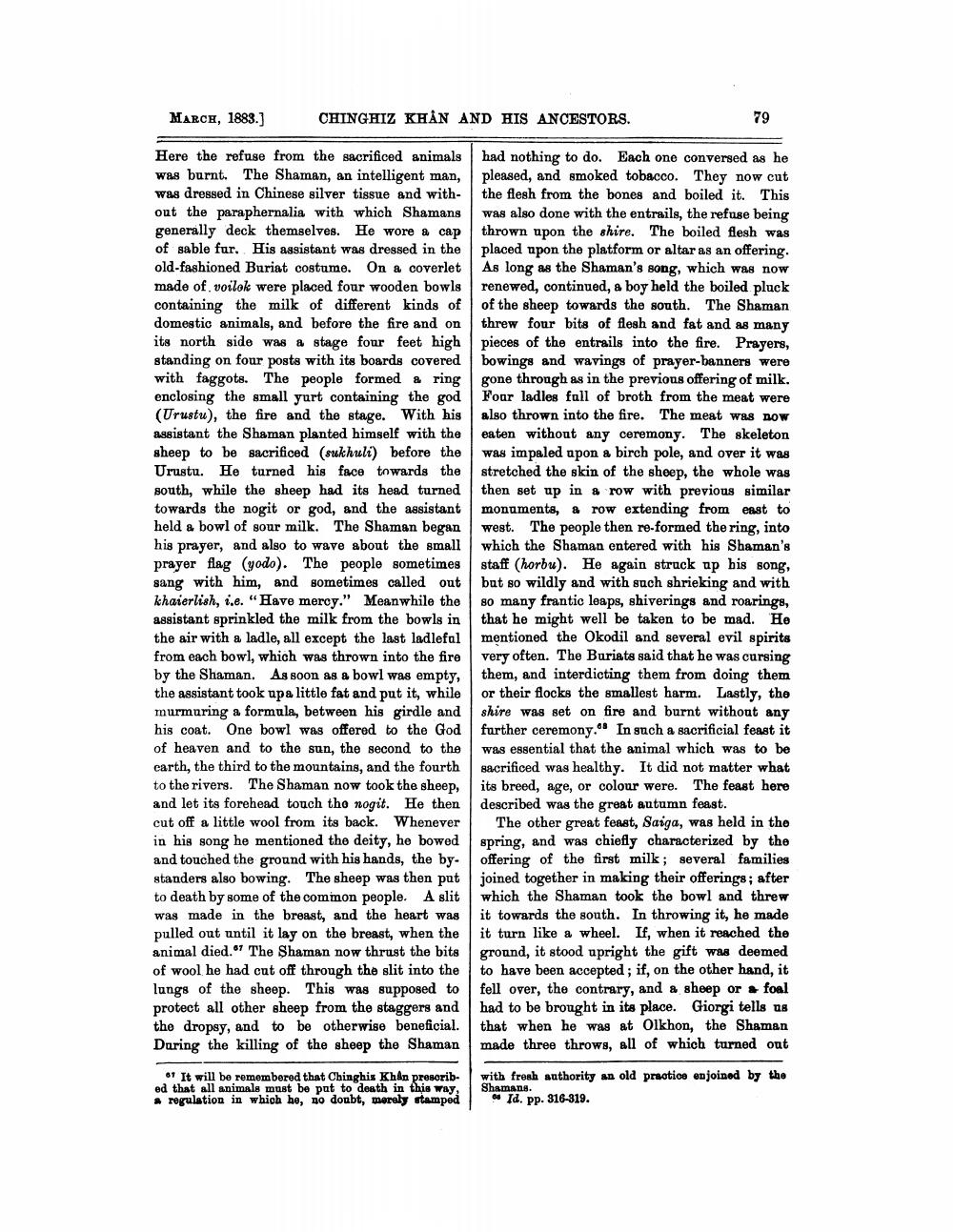________________
CHINGHIZ KHAN AND HIS ANCESTORS.
MARCH, 1883.]
Here the refuse from the sacrificed animals was burnt. The Shaman, an intelligent man, was dressed in Chinese silver tissue and without the paraphernalia with which Shamans generally deck themselves. He wore a cap of sable fur. His assistant was dressed in the old-fashioned Buriat costume. On a coverlet made of. voilok were placed four wooden bowls containing the milk of different kinds of domestic animals, and before the fire and on its north side was a stage four feet high standing on four posts with its boards covered with faggots. The people formed a ring enclosing the small yurt containing the god (Urustu), the fire and the stage. With his assistant the Shaman planted himself with the sheep to be sacrificed (sukhuli) before the Urustu. He turned his face towards the south, while the sheep had its head turned towards the nogit or god, and the assistant held a bowl of sour milk. The Shaman began his prayer, and also to wave about the small prayer flag (yodo). The people sometimes sang with him, and sometimes called out khaierlish, i.e. "Have mercy." Meanwhile the assistant sprinkled the milk from the bowls in the air with a ladle, all except the last ladleful from each bowl, which was thrown into the fire by the Shaman. As soon as a bowl was empty, the assistant took up a little fat and put it, while murmuring a formula, between his girdle and his coat. One bowl was offered to the God of heaven and to the sun, the second to the earth, the third to the mountains, and the fourth to the rivers. The Shaman now took the sheep, and let its forehead touch the nogit. He then cut off a little wool from its back. Whenever in his song he mentioned the deity, he bowed and touched the ground with his hands, the bystanders also bowing. The sheep was then put to death by some of the common people. A slit was made in the breast, and the heart was pulled out until it lay on the breast, when the animal died." The Shaman now thrust the bits of wool he had cut off through the slit into the lungs of the sheep. This was supposed to protect all other sheep from the staggers and the dropsy, and to be otherwise beneficial. During the killing of the sheep the Shaman
67 It will be remembered that Chinghis Khan prescribed that all animals must be put to death in this way, a regulation in which he, no doubt, merely stamped
79
had nothing to do. Each one conversed as he pleased, and smoked tobacco. They now cut the flesh from the bones and boiled it. This was also done with the entrails, the refuse being thrown upon the shire. The boiled flesh was placed upon the platform or altar as an offering. As long as the Shaman's song, which was now renewed, continued, a boy held the boiled pluck of the sheep towards the south. The Shaman threw four bits of flesh and fat and as many pieces of the entrails into the fire. Prayers, bowings and wavings of prayer-banners were gone through as in the previous offering of milk. Four ladles full of broth from the meat were also thrown into the fire. The meat was now eaten without any ceremony. The skeleton was impaled upon a birch pole, and over it was stretched the skin of the sheep, the whole was then set up in a row with previous similar monuments, a row extending from east to west. The people then re-formed the ring, into which the Shaman entered with his Shaman's staff (horbu). He again struck up his song, but so wildly and with such shrieking and with so many frantic leaps, shiverings and roarings, that he might well be taken to be mad. He mentioned the Okodil and several evil spirits very often. The Buriats said that he was cursing them, and interdicting them from doing them or their flocks the smallest harm. Lastly, the shire was set on fire and burnt without any further ceremony. In such a sacrificial feast it was essential that the animal which was to be sacrificed was healthy. It did not matter what its breed, age, or colour were. The feast here described was the great autumn feast.
The other great feast, Saiga, was held in the spring, and was chiefly characterized by the offering of the first milk; several families joined together in making their offerings; after which the Shaman took the bowl and threw it towards the south. In throwing it, he made it turn like a wheel. If, when it reached the ground, it stood upright the gift was deemed to have been accepted; if, on the other hand, it fell over, the contrary, and a sheep or a foal had to be brought in its place. Giorgi tells us that when he was at Olkhon, the Shaman made three throws, all of which turned out
with fresh authority an old practice enjoined by the
Shamans.
6 Id. pp. 316-319.




